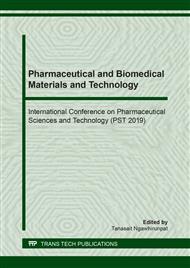p.73
p.79
p.85
p.92
p.98
p.104
p.111
p.118
p.124
Characteristic Assessment of the Polymeric Films Used for Hair Gel Products in Thailand
Abstract:
The market of hair gel products in Thailand steadily grows with the changing trend of fashion every year. The main component of the hair gel products is the fixative polymer, which plays a role in hair styling properties including stiffness and curl retention. Properties of the hair styling product depending on hair types and climates must be suitably improved for Thai hair. In this study, 10 %w/w gel solutions of polyacrylic acid, polyquaternium-86, polyvinylpyrrolidone (PVP), acrylates copolymer, and vinylpyrrolidone (VP) copolymers were cast as polymeric thin films. The film properties such as mechanical properties, wettability, and crystallinity were characterized afterwards. As a result, the highest puncture strength of 2.2 N/mm2 was found from PVP-K90 film (500-700 μm thick). Whereas, VP/vinyl acetate (VA) copolymer film was the most flexible with 42.5% elongation. For water contact angle analysis, it was noticed that VP copolymers had the angle of ~50o indicating the moderate wettability. The x-ray patterns of raw materials, polymeric films, and humidified films were varied especially for PVP-K30. Morphologies of the Thai hair samples coated with the fixative polymers were visualized through SEM. After storing coated hair samples in the humidified atmosphere (95±2% Relative humidity), acrylates copolymer, VP/Methacrylamide/Vinyl Imidazole copolymer, and VP/VA copolymer appeared the humidity resistance suitable for Thai hair styling gel.
Info:
Periodical:
Pages:
98-103
Citation:
Online since:
August 2019
Price:
Сopyright:
© 2019 Trans Tech Publications Ltd. All Rights Reserved
Share:
Citation:


